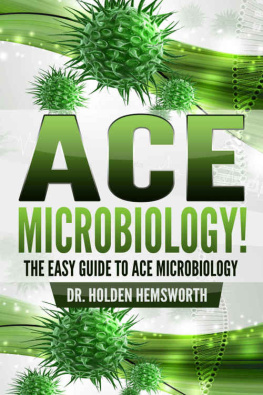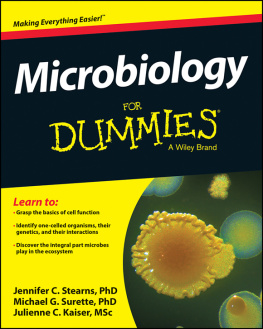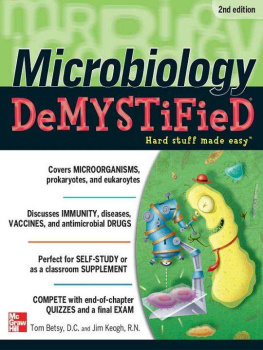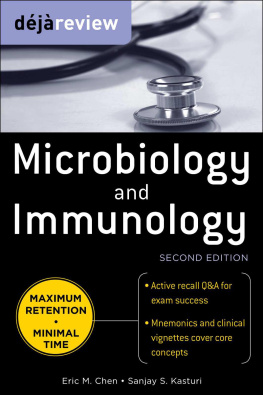Ace Microbiology!
(The Easy Guide to Ace Microbiology)
By: Dr. Holden Hemsworth
Copyright 2015 by Holden Hemsworth
All rights reserved. No part of this publication may be reproduced, distributed, or transmitted in any form or by any means, including photocopying, recording, or other electronic or mechanical methods, without the prior written permission of the publisher, except in the case of brief quotations embodied in critical reviews and certain other noncommercial uses permitted by copyright law.
Disclaimer
Microbiology, like any field of science, is continuously changing and new information continues to be discovered. The author and publisher have reviewed all information in this book with resources believed to be reliable and accurate and have made every effort to provide information that is up to date and correct at the time of publication. Despite our best efforts we cannot guarantee that the information contained herein is complete or fully accurate due to the possibility of the discovery of contradictory information in the future and any human error on part of the author, publisher, and any other party involved in the production of this work. The author, publisher, and all other parties involved in this work disclaim all responsibility from any errors contained within this work and from any results that arise from the use of this information. Readers are encouraged to check all information in this book with institutional guidelines, other sources, and up to date information.
The information contained in this book is provided for general information purposes only and does not constitute medical, legal or other professional advice on any subject matter. The author or publisher of this book does not accept any responsibility for any loss which may arise from reliance on information contained within this book or on any associated websites or blogs.
Why I Created This Study Guide
In this book, I try to breakdown the content covered in most introductory Microbiology courses in college for easy understanding and to point out the most important subject matter that students are likely to encounter. This book is meant to be a supplemental resource to lecture notes and textbooks to boost your learning and go hand in hand with your studying!
I am committed to providing my readers with books that contain concise and accurate information and I am committed to providing them tremendous value for their time and money. I hope you find this guide extremely beneficial and informatory.
Best regards,
Dr. Holden Hemsworth
Your reviews greatly help reach more students. If you find this book helpful, please click below to leave a review on Amazon or to share the book on Facebook. Nothing helps more than a few kind words.


Table of Contents
Introduction to Microbes
Humans have to utilize specific magnifying optical instruments in order to be able to view microorganisms (microbes) as they are too small to be viewed by the naked eye.
Major Groups of Microorganisms
- Bacteria
- Unicellular
- Prokaryotic
- Reproduce through binary fission
- Form of asexual reproduction, one cell reproduces by dividing into two almost identical cells
- Common morphology: cocci (spherical), bacilli (rod-shaped), vibrio (curved rods), spirilla (spiral shaped)
Morphology: 
- Archaea
- Unicellular
- Prokaryotic
- Mostly found in extreme environments
- Three main groups:
- Methanogens produce methane as a waste product
- Extreme halophiles live in very high salt concentrations
- Extreme thermophiles live in incredibly high temperatures
- Viruses
General Virus Structure Example: 
- Can only reproduce using the cellular machinery of a host cell
- Viral genome can be either RNA or DNA
- Algae
- Eukaryotic
- Photosynthetic
- Cell walls composed of cellulose
- Protozoa
- Unicellular
- Eukaryotic
- Mobility achieved through flagella, cilia, or pseudopods
- Fungi
- Eukaryotic
- Unicellular or multicellular
- Cell walls composed primarily of chitin
Nomenclature
The system of naming organisms was established in 1735 by Carolus Linnaeus.
- Scientific names are Latinized
- Each organism has a genus name and specific epithet (species name)
- Both the genus and species names are either underlined or italicized
- The first letter of the genus name is always capitalized
- The species name is entirely lowercase
- After being first used in its entirety, the name can be abbreviated in the text that follows by using an initial of the genus followed by the full species name
Example: Escherichia coli or Escherichia coli
- Genus Name: Escherichia
- Species Name: coli
- Abbreviation: E. coli
The Three Domains of Life
Introduced by Carl Woese in 1977, the three domains of life is a system of biological classification based off of rRNA sequences of organisms.
- Bacteria
- Archaea
- Eukarya
- Includes: Protists, fungi, plants, animals

Abbreviated History of Microbiology
At the start of the development of microbiology two hypotheses sought to explain the origin of life, spontaneous generation and biogenesis. Spontaneous generation claimed that living organisms come from nonliving matter and biogenesis claimed that living organisms arise from preexisting life.
Competitive Hypotheses
- 1665 - Robert Hooke reported that living things were composed of cells
- 1668 - Francisco Redi demonstrated that maggots did not arise spontaneously from decaying meat
- 1673 - Antoni van Leeuwenhoek observed the first microbes and called them animalcule
- 1857 Louis Pasteur demonstrated that microbes (yeast) are responsible for fermentation (conversion of sugar to alcohol to make beer and wine)
- 1861 - Pasteur disproved the theory of spontaneous generation
- 1876 - Robert Koch proved that a bacterium causes anthrax and comes up with Kochs postulates
Birth of Chemotherapy
Treatments for diseases that utilize chemicals is called chemotherapy. Chemotherapeutic agents can be drugs or antibiotics (chemicals produced by bacteria and fungi that inhibit or kill other microbes).
- 1910 - Paul Ehrlich developed a synthetic drug to treat syphilis
- 1928 - Alexander Fleming discovered the first antibiotic
- 1930s - Sulfonamides (basis of several groups of drugs) were synthesized
- 1940s - Penicillin was tested clinically and mass-produced
Genetics and Recombinant DNA Technology
- 1953 - Watson and Crick developed a 3D model of the structure of DNA














